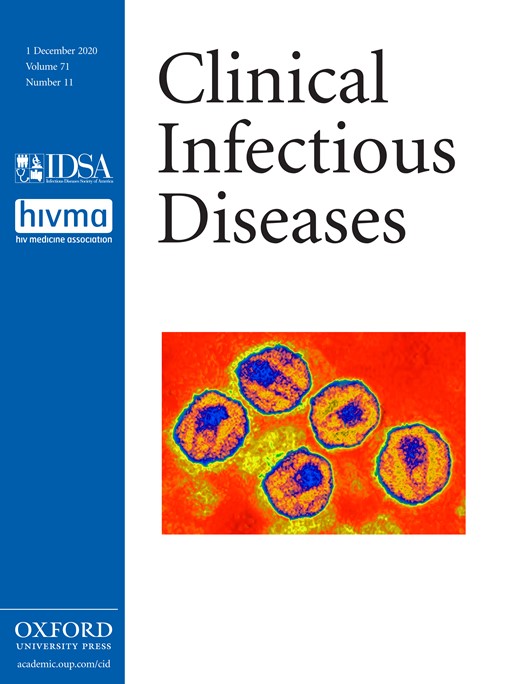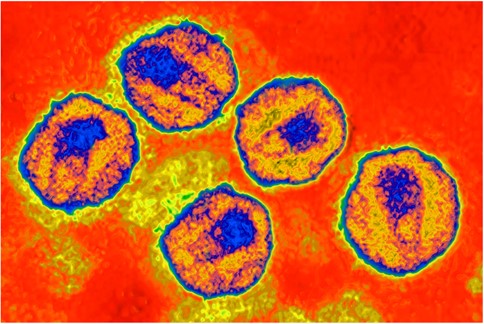
Cover image

Volume 71, Issue 11, 1 December 2020
In The Literature
In The Literature
MAJOR ARTICLES AND COMMENTARIES
A Phase 2, Randomized, Double-blind, Placebo-Controlled Trial of Presatovir for the Treatment of Respiratory Syncytial Virus Upper Respiratory Tract Infection in Hematopoietic-Cell Transplant Recipients
Presatovir treatment was safe but did not improve viral or clinical outcomes in hematopoietic-cell transplant recipients with respiratory syncytial virus upper respiratory tract infections. Exploratory analyses suggest clinical benefit in hematopoietic-cell transplant patients with lymphopenia at presentation.
A Phase 2b, Randomized, Double-blind, Placebo-Controlled Multicenter Study Evaluating Antiviral Effects, Pharmacokinetics, Safety, and Tolerability of Presatovir in Hematopoietic Cell Transplant Recipients with Respiratory Syncytial Virus Infection of the Lower Respiratory Tract
Presatovir treatment was safe but did not improve viral or clinical outcomes in hematopoietic-cell transplant recipients with respiratory syncytial virus lower respiratory tract infection. Future studies in this population should incorporate novel methods to evaluate virus-related injury and treatment effects.
Clinical Development of Respiratory Syncytial Virus Antivirals—What We Can Learn From Oseltamivir
Global Burden of Hepatitis B Infection in People Living With Human Immunodeficiency Virus: A Systematic Review and Meta-analysis
In this meta-analysis of 834 544 HIV-infected people from 87 countries, the global prevalence of hepatitis B infection is high (8.4%), with substantial heterogeneity by UNAIDS region. The burden is higher in sub-Saharan Africa, followed by Asia and the Pacific.
Hepatitis B Infection in People Living With Human Immunodeficiency Virus: A Global Challenge Needing More Research
Prediction of Esophageal Varices by Liver Stiffness and Platelets in Persons With Human Immunodeficiency Virus Infection and Compensated Advanced Chronic Liver Disease
People living with Human Immunodeficiency Virus (HIV) are at high risk for cirrhosis and esophageal varices. Baveno VI and expanded Baveno VI criteria based on transient elastography and platelets can spare esophagogastroduodenoscopies. These criteria can be safely expanded to HEPAVIR and HIV cirrhosis criteria.
Cat Scratch Disease Presenting as Fever of Unknown Origin Is a Unique Clinical Syndrome
Cat scratch disease presenting as fever of unknown origin may be severe and debilitating and often mimics malignancy. Relapsing fever is a common clinical phenotype. Multiorgan involvement is common. Recovery is usually complete except in patients with ocular complications.
Long-term Mortality and Epilepsy in Patients After Brain Abscess: A Nationwide Population-Based Matched Cohort Study
Using a nationwide and population-based registries, we conducted the first ever matched cohort study of brain abscess and show a significantly increased mortality for up to 30 years after infection and a cumulative incidence of new-onset epilepsy of 32%.
Clinical Factors Associated With Congenital Cytomegalovirus Infection: A Cohort Study of Pregnant Women and Newborns
The presence of maternal fever/flulike symptoms and threatened miscarriage/threatened premature labor in the second trimester were clinical factors associated with the occurrence of congenital CMV infection of newborns.
Hepatitis C Virus Cure Rates Are Reduced in Patients With Active but Not Inactive Hepatocellular Carcinoma: A Practice Implication
We found no significant difference in treatment tolerability or completion rate between DAA-treated patients with and without Hepatocellular Carcinoma (HCC). Non-HCC and inactive HCC patients had similar cure rate (95%) but not active HCC (85%), an independent risk factor for lower SVR.
Increase of Dose Associated With Decrease in Protection Against Controlled Human Malaria Infection by PfSPZ Vaccine in Tanzanian Adults
In Tanzania, increasing the total dosage of PfSPZ Vaccine from 1.35 × 106 to 2.7 × 106 PfSPZ, increased vaccine efficacy from 20% to 100%, but increasing the dosage further to 5.4 × 106 PfSPZ was associated with reduction of vaccine efficacy to 33%.
Cotrimoxazole Prophylaxis Increases Resistance Gene Prevalence and α-Diversity but Decreases β-Diversity in the Gut Microbiome of Human Immunodeficiency Virus–Exposed, Uninfected Infants
Cotrimoxazole treatment in HIV-exposed, uninfected (HEU) infants increases resistance gene prevalence and α-diversity, and decreases microbial taxonomic, functional pathway, and resistance gene β-diversity. Future HEU infant prophylaxis recommendations should consider these findings given rising global antibiotic resistance.
Cotrimoxazole Prophylaxis Selects for Antimicrobial Resistance in Human Immunodeficiency Virus–Exposed, Uninfected Infants
Postexposure Prophylaxis With rVSV-ZEBOV Following Exposure to a Patient With Ebola Virus Disease Relapse in the United Kingdom: An Operational, Safety, and Immunogenicity Report
The rVSV-ZEBOV vaccine was used as postexposure prophylaxis in individuals exposed to Ebola virus in the United Kingdom. It was rolled out rapidly and was generally well tolerated. Side effects correlated with the magnitude of CD8+ T-cell responses.
Multimorbidity in Elderly Persons According to the Year of Diagnosis of Human Immunodeficiency Virus Infection: A Cross-sectional Dat’AIDS Cohort Study
We assessed multimorbidity according to the period of Human Immunodeficiency Virus (HIV) diagnosis in 2476 people aged ≥70 years living with HIV. Multimorbidity was associated with older age, CD4/CD8 ratio, and nadir CD4 cell count, but not period of HIV diagnosis.
Clinical Impact of Rapid Drug Susceptibility Testing to Accompany Fluoroquinolone-Containing Universal Tuberculosis Regimens: A Markov Model
Future first-line tuberculosis treatment may include fluoroquinolones and/or require testing for fluoroquinolone susceptibility. We use a quantitative model to demonstrate that optimal approaches to fluoroquinolone susceptibility testing depend on local resistance patterns, associations with identifiable risk factors, and regimen robustness.
Impact of a Comprehensive Antimicrobial Stewardship Program on Institutional Burden of Antimicrobial Resistance: A 14-Year Controlled Interrupted Time-series Study
Implementation of a comprehensive antimicrobial stewardship program (ASP) significantly reduced nosocomial antimicrobial resistance (AMR) even though community AMR (control) increased during the same period. This study provides evidence that ASPs play an important role in the fight against AMR.
Human Immunodeficiency Virus Continuum of Care in 11 European Union Countries at the End of 2016 Overall and by Key Population: Have We Made Progress?
Standardized definitions were used to estimate a 4-stage continuum of human immunodeficiency virus (HIV) care in 11 European Union (EU) countries in 2016. The EU is close to the 90-90-90 target, with the main challenge being the percentage of undiagnosed infections.
European Union, HIV, and Coronavirus Disease 2019 (COVID-19): Progress and Lessons Learned From the HIV Pandemic
Asymptomatic SARS-CoV-2 Infection and COVID-19 Mortality During an Outbreak Investigation in a Skilled Nursing Facility
In an investigation of the first known outbreak of severe acute respiratory syndrome coronavirus 2 (SARS-CoV-2) in a skilled nursing facility in Illinois, we found that 39% of confirmed cases remained asymptomatic, and the 30-day probability of death was 29%.
Distribution of Transmission Potential During Nonsevere COVID-19 Illness
Distribution of transmission potential during nonsevere COVID-19 was examined. Viral loads in upper respiratory specimens peak by 2 or 3 days from symptom onset. The vast majority of the viral load-time AUCs lie within 10 days of symptom onset.
Coronavirus 2019 and People Living With Human Immunodeficiency Virus: Outcomes for Hospitalized Patients in New York City
There are limited data on coronavirus disease 2019 (COVID-19) clinical outcomes for people living with human immunodeficiency virus (PLWH). We report outcomes for a cohort of hospitalized PLWH with COVID-19 compared with demographically matched comparators. Major adverse outcomes were similar for PLWH and matched comparators.
Posterior Oropharyngeal Saliva for the Detection of Severe Acute Respiratory Syndrome Coronavirus 2 (SARS-CoV-2)
Clinic Conundrum
Unmasking the Actual COVID-19 Case Count
Toward a Better Case Fatality Estimate for Severe Acute Respiratory Syndrome Coronavirus 2 During the Early Phase of the United States Outbreak
BRIEF REPORTS
Impact of the Allergy Clarification for Cefazolin Evidence-based Prescribing Tool on Receipt of Preferred Perioperative Prophylaxis: An Interrupted Time Series Study
Universal Face Masking Reduces Respiratory Viral Infections Among Inpatient Very-Low-Birthweight Neonatal Infants
Hydroxychloroquine in Coronavirus Disease 2019 Patients: What Still Needs to Be Known About the Kinetics
Dose Optimization of Hydroxychloroquine for Coronavirus Infection 2019: Do Blood Concentrations Matter?
“Ending the Epidemic” Will Not Happen Without Addressing Racial/Ethnic Disparities in the United States Human Immunodeficiency Virus Epidemic
Penicillin Allergy Evaluation Access: A National Survey
Associations of Early COVID-19 Cases in San Francisco With Domestic and International Travel
Individualized Treatment of Multidrug-resistant Tuberculosis Using Whole-Genome Sequencing and Expanded Drug-Susceptibility Testing
VIEWPOINTS
Ethical and Practical Issues Associated With the Possibility of Using Controlled Human Infection Trials in Developing a Hepatitis C Virus Vaccine
Effective means of preventing hepatitis C virus (HCV) infection, such as a vaccine, are needed. Controlled infection trials could facilitate HCV vaccine development, but they raise substantial ethics and practical concerns that require further deliberation as they are planned and implemented.
Striving for Hepatitis C Elimination: The Role of a Vaccine
Where Is the Implementation Science? An Opportunity to Apply Principles During the COVID-19 Pandemic
Implementation science offers a valuable set of tools to ensure that best practices are optimally delivered, and thus must assert a nimble presence before, during, and after a pandemic.
REVIEW ARTICLE
The Laboratory Diagnosis of Coronavirus Disease 2019— Frequently Asked Questions
The ability to detect the SARS-CoV-2 coronavirus in respiratory secretions is essential to determine when an individual is infected and potentially infectious to others. This article discusses questions commonly asked by clinicians about COVID-19 diagnostic testing.
INVITED ARTICLE
INNOVATIONS IN DESIGN, EDUCATION AND ANALYSIS (IDEA)
Resist the Temptation of Response-Adaptive Randomization
Response-adaptive randomization (RAR) is a noble attempt to increase the likelihood that patients receive better-performing treatments, but it causes numerous problems that more than offset any potential benefits. We discourage the use of RAR in clinical trials.
PHOTO QUIZ
Intracellular Pathogen in the Cerebrospinal Fluid of an Allogeneic Hematopoietic Cell Transplant Recipient With Graft-Versus-Host Disease and Brain Lesions
CORRESPONDENCE
Hepatitis C and Stimulant Use Disorder: Challenges and Opportunities
Enterococcal Endocarditis: The Eternal Return of the Same Bug
Reply to Pericàs et al
Influenza Challenge Models: Ready for Prime Time?
Reply to Bernstein, Atmar, and Hoft
A Multicenter, Longitudinal Cohort Study of Cryptococcosis in Human Immunodeficiency Virus–Negative People in the United States
Reply to Pan et al
Seroconversion Rate and Diagnostic Accuracy of Serological Tests for Coronavirus 2019
Reply to Nagappa and Marimuthu
Olfactory and Gustatory Symptoms in European COVID-19 Cohorts
Reply to Gourtsoyannis
ERRATUM
Erratum to: Changes in Inflammation and Immune Activation With Atazanavir-, Raltegravir-, Darunavir-Based Initial Antiviral Therapy: ACTG 5260s
CORRIGENDUM
Corrigendum to: Treatment of Nontuberculous Mycobacterial Pulmonary Disease: An Official ATS/ERS/ESCMID/IDSA Clinical Practice Guideline
ONLINE ONLY ARTICLES
MAJOR ARTICLES
Regional Emergence of Candida auris in Chicago and Lessons Learned From Intensive Follow-up at 1 Ventilator-Capable Skilled Nursing Facility
This report describes Candida auris emergence in Chicago during August 2016–December 2018, and public health response at one ventilator-capable skilled nursing facility with high colonization burden. Improved adherence to infection control and environmental disinfection is needed to control spread.
Reducing Antibiotic Use in Ambulatory Care Through Influenza Vaccination
We enrolled outpatients with acute respiratory illness (ARI) during 5 winters (2013–2018). We estimated that influenza vaccination prevented 5.6% of all ARI syndromes, with syndrome-specific estimates ranging from 2.8% (sinusitis) to 11% (clinical influenza) and thus averted 1 in 25 antibiotic prescriptions.
Preferential Infection of α4β7+ Memory CD4+ T Cells During Early Acute Human Immunodeficiency Virus Type 1 Infection
We demonstrate that memory CD4+ T cells expressing high levels of integrin β7 are enriched in total and integrated HIV-1 DNA compared to β7negative cells, and that preferential targeting of β7high cells is associated with their activation status.



